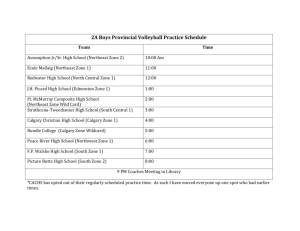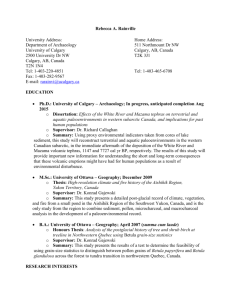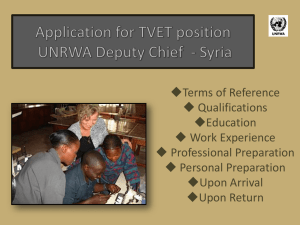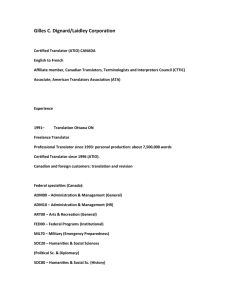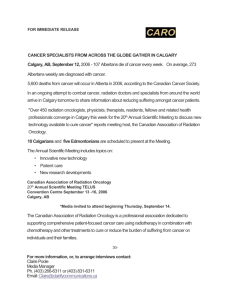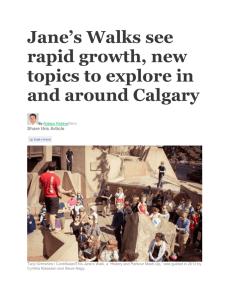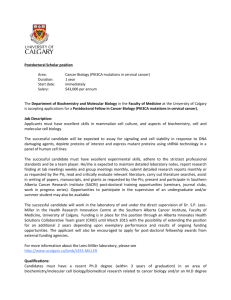Rebecca A. Rainville - University of Calgary
advertisement
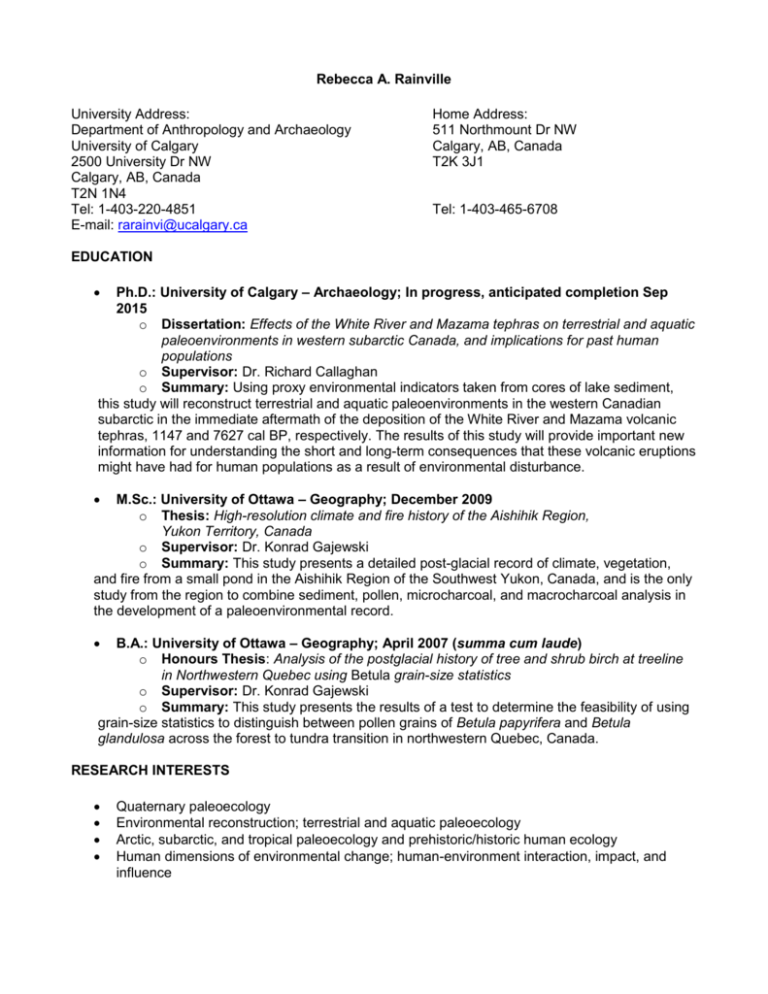
Rebecca A. Rainville University Address: Department of Anthropology and Archaeology University of Calgary 2500 University Dr NW Calgary, AB, Canada T2N 1N4 Tel: 1-403-220-4851 E-mail: rarainvi@ucalgary.ca Home Address: 511 Northmount Dr NW Calgary, AB, Canada T2K 3J1 Tel: 1-403-465-6708 EDUCATION Ph.D.: University of Calgary – Archaeology; In progress, anticipated completion Sep 2015 o Dissertation: Effects of the White River and Mazama tephras on terrestrial and aquatic paleoenvironments in western subarctic Canada, and implications for past human populations o Supervisor: Dr. Richard Callaghan o Summary: Using proxy environmental indicators taken from cores of lake sediment, this study will reconstruct terrestrial and aquatic paleoenvironments in the western Canadian subarctic in the immediate aftermath of the deposition of the White River and Mazama volcanic tephras, 1147 and 7627 cal BP, respectively. The results of this study will provide important new information for understanding the short and long-term consequences that these volcanic eruptions might have had for human populations as a result of environmental disturbance. M.Sc.: University of Ottawa – Geography; December 2009 o Thesis: High-resolution climate and fire history of the Aishihik Region, Yukon Territory, Canada o Supervisor: Dr. Konrad Gajewski o Summary: This study presents a detailed post-glacial record of climate, vegetation, and fire from a small pond in the Aishihik Region of the Southwest Yukon, Canada, and is the only study from the region to combine sediment, pollen, microcharcoal, and macrocharcoal analysis in the development of a paleoenvironmental record. B.A.: University of Ottawa – Geography; April 2007 (summa cum laude) o Honours Thesis: Analysis of the postglacial history of tree and shrub birch at treeline in Northwestern Quebec using Betula grain-size statistics o Supervisor: Dr. Konrad Gajewski o Summary: This study presents the results of a test to determine the feasibility of using grain-size statistics to distinguish between pollen grains of Betula papyrifera and Betula glandulosa across the forest to tundra transition in northwestern Quebec, Canada. RESEARCH INTERESTS Quaternary paleoecology Environmental reconstruction; terrestrial and aquatic paleoecology Arctic, subarctic, and tropical paleoecology and prehistoric/historic human ecology Human dimensions of environmental change; human-environment interaction, impact, and influence Paleoecology of wetland, coastal, and marine environments; development, degradation, disturbance and change in these environments, and its implications; modern wetland, coastal, and marine environmental change and its implications Floral, faunal, and human colonization and inhabitation of new environments; impacts of volcanic ash-falls and other disturbance events; early post-glacial paleoecology and human ecology Humans in island environments; island biogeography and prehistoric/historic human ecology on islands Applications of paleoecological research to modern concerns (e.g. climate change, conservation) RELEVANT EXPERIENCE AND SKILLS Project design and planning Organization and performance of pollen, charcoal, chironomid, and diatom preparation, analysis, and identification Organization and performance of loss-on-ignition, magnetic susceptibility, particle size, and biogenic silica laboratory and data analysis Field season organization; archaeological and environmental field work (e.g. archaeological survey, excavation, site recording, lake coring, dendrochronology, soil and water sampling, etc.) Organization and performance of 210Pb and 14C sample preparation, results analysis, and construction of chronologies Multivariate and other statistical analysis and interpretation Report production, including writing and editing, and figure and table design and production Analysis of large datasets; database work Setup of new laboratory procedures Training of staff and students in field and laboratory techniques and protocols Management of day-to-day laboratory activities, including organization of staff and students, and lab and work schedules Sample and artifact curation Participation in public outreach activities Teaching, including lecture and laboratory exercise preparation and delivery, student mentoring, and evaluation of submitted work PUBLICATIONS ** Please note – publications prepared prior to 2010 were submitted using my maiden name (Rebecca Ravindra) Rainville, Rebecca and Konrad Gajewski. 2012. “Holocene environmental history of the Aishihik Region, Yukon, Canada.” Canadian Journal of Earth Sciences 50:397-405. doi: 1139/cjes-2012-0103. Abstract: A 2.7 m sediment core from WA01, a small pond in Southwest Yukon, Canada (unofficial name, 61°14′41″N, 136°55′35″W, 1000 m above sea level), documents the postglacial vegetation and climate history of the Aishihik Basin. Open birch–shrub tundra established at the site ca. 10 900 cal years BP, immediately after deglaciation. Picea glauca established ca. 10 200 cal years BP, and an open spruce forest ecosystem has since remained dominant on the landscape. A gradual increase in Alnus crispa, starting ca. 6600 cal years BP, has also been noted in other studies from Central Yukon, suggesting a significant climate transition in Yukon at this time. An alternating pattern in sediment loss-on-ignition, also beginning ca. 6600 cal years BP, may be broadly related to trends in ∂18O values from the Mount Logan and Jellybean Lake oxygen isotope records, and is most likely reflective of periodic changes in available moisture in the region resulting from alterations in the strength and position of the Aleutian Low pressure system. However, millennial-scale climate variability identified in ice core and sediment records had little impact on the forests of the region. Based on the results of my M.Sc. thesis. Led the project and personally performed the majority of tasks, including: project design and planning, organization and performance of laboratory processing and analysis (including sediment logging, magnetic susceptibility, LOI, pollen, microcharcoal, and macrocharcoal), data analysis and interpretation, writing, editing, figure and table design and production, preparation for publication, manuscript submission, corrections, and responses to reviewer comments. Peros, Matthew, Konrad Gajewski, Tara Paull, Rebecca Ravindra, and Brandi Podritske. 2010. “Multi-proxy record of postglacial environmental change, south-central Melville Island, Northwest Territories, Canada.” Quaternary Research 73:247-258. Abstract: A sediment core from Lake BC01 (75°10.945′N, 111°55.181′W, 225 m asl) on southcentral Melville Island, NWT, Canada, provides the first continuous postglacial environmental record for the region. Pollen-based climate reconstructions suggests the presence of a cold and dry period ~12,000 cal yrs BP, followed by warmer and wetter conditions from 11,000 to 5,000 cal yrs BP. The climate then underwent a gradual cooling and drying from 5,000 cal yrs BP to the present. An abrupt warming occurred during the past 70 yrs at the site, although the magnitude of this warming did not exceed that of the early Holocene. Diatom preservation was poor prior to 5,000 cal yrs BP, when conditions were warmest, suggesting that diatom dissolution may in part be climatically controlled. Diatom concentrations were highest ~4,500 cal yrs BP but then decreased substantially by 3,500 cal yrs BP and remained low before recovering slightly in the 20th century. Played a lead role in the project, including in: project design and planning, organization and performance of laboratory processing and analysis (including sediment logging, magnetic susceptibility, LOI, pollen, and diatoms), data analysis and interpretation, writing, editing, figure and table design and production, and preparation for publication. CONFERENCE PRESENTATIONS, PAPERS, AND POSTERS ** Please note – Conference presentation, papers, and posters given prior to 2010 were presented using my maiden name (Rebecca Ravindra). Presenter is marked with a leading *. *Rainville, Rebecca. 2013. “Environmental Effects of the White River Tephra, Southern Yukon, Canada, and Their Implications for Human and Animal Populations in the Region: A High-Resolution, Multi-Proxy Study.” Paper presented at the meeting for the Society for American Archaeology, Honolulu, HI, USA, Apr 3-7. *Rainville, Rebecca. 2011. “High-resolution Vegetation History of the Aishihik Region, Yukon Territory, Canada: Grassland or no grassland? And Other Unanswered Mysteries.” Paper presented at the meeting for the Chacmool Association, Calgary, AB, Canada, Nov 9-13. *Graham, Taylor, Rebecca Rainville, Josef Moravetz, and Richard Callaghan. 2010. "’Did You Find Any Gold?’: Archaeology on a National Stage.” Paper presented at the meeting for the Chacmool Association, Calgary, AB, Canada, Nov 11-14. *Peros, Matthew, Konrad Gajewski, Tara Paull, Rebecca Ravindra, and Brandi Podritske. 2008. “Late Glacial and Holocene Environments of South-Central Melville Islands, Northwest Territories, Canada.” Paper presented at the meeting for the American Geophysical Union, San Francisco, CA, USA, Dec 15-19. *Ravindra, Rebecca, and Konrad Gajewski. 2008. “Hydroclimatic variability inferred from lake sediments from the Aishihik Region, southwest Yukon Territory.” Paper presented at the Frontiers in Research – The Disappearing North/Ottawa-Carleton Student Northern Research Symposium, Ottawa, ON, Canada, Oct 23. *Ravindra, Rebecca, and Konrad Gajewski. 2007. “Postglacial history of tree and shrub birch at treeline in Northwestern Quebec using Betula grain-size statistics.” Paper presented at the meeting for the Canadian Quaternary Association, Ottawa, ON, Canada, June 4-8. *Ravindra, Rebecca. 2005. “Introduction to Northern Research: Undergraduates in the Southwest Yukon, Summer 2005.” Paper presented at the meeting for the Canadian Association of Geographers of Ontario, Ottawa, ON, Canada, Oct 28-29. HONOURS University of Calgary Graduate Faculty Council Doctoral Scholarship – 2013 University of Calgary Graduate Students’ Association Professional Development Grant – 2013 University of Calgary Faculty of Graduate Studies Travel Award – 2013 University of Calgary Queen Elizabeth II Graduate Scholarships (Doctoral) – 2011 (declined due to previous acceptance of Natural Sciences and Engineering Research Council PGS D Award), 2012, 2013, 2014 University of Calgary Chancellor’s Challenge Graduate Scholarship – 2011, 2014 University of Calgary Pepsi Bottling Group Graduate Scholarship – 2011 (replaced with Chancellor’s Challenge Graduate Scholarship) University of Calgary Calgary Chamber of Commerce and ENMAX Graduate Scholarship in Global Climate Change Research – 2011 Natural Sciences and Engineering Research Council PGS D Award – 2009-2010 University of Calgary Dean's Research Excellence Award (NSERC) – 2009, 2010 University of Calgary Dean's Entrance Scholarship – 2009 University of Ottawa Dean’s Scholarship – 2009 Natural Sciences and Engineering Research Council PGS M Extension – 2008 Northern Scientific Training Program Canada Research Award – 2008 Yukon Territory Northern Research Institute Fellowship Endowment – 2008 Natural Sciences and Engineering Research Council CGS M Award – 2007 Ontario Graduate Scholarship – 2007-2008 (declined due to previous acceptance of Natural Sciences and Engineering Research Council CGS M Award and Natural Sciences and Engineering Research Council PGS M Extension) University of Ottawa Excellence Scholarship – 2007-2008 University of Ottawa Graduate Admission Scholarship – 2007-2008 (replaced with University of Ottawa Excellence Scholarship) Natural Sciences and Engineering Research Council Undergraduate Student Research Award – 2006, 2007 University of Ottawa Joseph-Marie Quirion Fellowship – 2006 University of Ottawa Zaborsky-Canstonguay Bursary – 2006 Canadian Association of Geographers Undergraduate Award – 2006 University of Ottawa Terry-Anne Dolan Memorial Bursary – 2005 University of Ottawa Undergraduate Admission Scholarship – 2003-2006 ACADEMIC, RESEARCH, AND OTHER RELEVANT WORK EXPERIENCE April 2010 – May 2010 Research Assistant, SSHRC Research Grant: Examining prehistoric community and social structure using ground penetrating radar, St Vincent and the Grenadines; Supervisor: Dr. Richard Callaghan, University of Calgary Organization and performance of archaeological survey, excavation, site recording, and sample and artifact curation; participation in public outreach activities. September 2009 – December 2009 Research Assistant, Carleton University Paleoecological Laboratory, Carleton University, Ottawa, ON; Supervisor: Dr. Mike Pisaric Organization and performance of fossil pollen, loss-on-ignition, magnetic susceptibility, and particle size laboratory and data analysis on sediments from northern Canada; management of day-to-day laboratory activities. January 2009 – April 2009 Research Assistant, Department of Geography, University of Ottawa, Ottawa, ON; Supervisor: Dr. Brian Ray Project design and planning; statistical analysis and interpretation of Canadian census data; report production including writing and editing, and figure and table design and production; analysis of large datasets/database work. May 2007 – August 2007 NSERC-USRA summer student, Laboratory for Paleoclimatology and Climatology, University of Ottawa, Ottawa, ON; Supervisor: Dr. Konrad Gajewski Project design and planning; organization and performance of fossil pollen, chironomid, and diatom preparation, analysis, and identification on sediments from northern Canada; loss-onignition, magnetic susceptibility, particle size, and biogenic silica laboratory and data analysis; 210 Pb and 14C sample preparation, results analysis, and construction of chronologies; multivariate and statistical analysis and interpretation; report production: writing and editing, figure and table design and production; analysis of large datasets/database work using pollen influx data from across North America; setup of biogenic silica laboratory protocol; training of staff and students in laboratory protocols; management of day-to-day laboratory activities, including organization of staff and students, and lab and work schedules. May 2006 – August 2006 NSERC-USRA summer student, Laboratory for Paleoclimatology and Climatology, University of Ottawa, Ottawa, ON; Supervisor: Dr. Konrad Gajewski Project design and planning; organization and performance of fossil pollen preparation, analysis, and identification on sediments from northern Quebec, Canada; data and statistical analysis and interpretation; report production including writing and editing, and figure and table design and production; training of staff and students in laboratory protocols; management of day-to-day laboratory activities, including organization of staff and students, and lab and work schedules. July 2005 – April 2006 Research Assistant, Laboratory for Paleoclimatology and Climatology, University of Ottawa, Ottawa, ON; Supervisor: Dr. Konrad Gajewski Project design and planning; organization and performance of fossil pollen, chironomid, and diatom preparation, analysis, and identification on sediments from northern Canada; loss-onignition, magnetic susceptibility, particle size, and biogenic silica laboratory and data analysis; 210 Pb and 14C sample preparation, results analysis, and construction of chronologies; multivariate and statistical analysis and interpretation; report production: writing and editing, figure and table design and production; analysis of large datasets/database work on a variety of paleoecological and environmental datasets. TEACHING EXPERIENCE Guest Lecturer – Winter 2015: ARKY515 – Paleoethnobotany, University of Calgary, Calgary, AB Teaching Assistant – Fall 2014: ARKY327 – Archaeology and the Media, University of Calgary, Calgary, AB Teaching Assistant – Winter 2014: ARKY533 – Microtraces, University of Calgary, Calgary, AB Teaching Assistant – Fall 2013: ARKY515 – Paleoethnobotany, University of Calgary, Calgary, AB Teaching Assistant – Winter 2013: ARKY205 – Ancient Peoples and Places, University of Calgary, Calgary, AB Teaching Assistant – Fall 2011, Fall 2012: ARKY201 – Introduction to Archaeology, University of Calgary, Calgary, AB Teaching Assistant - Spring/Summer 2008: GEG3300 A – Understanding the Marine Environment, University of Ottawa, Ottawa, ON Teaching Assistant - Fall 2008, Fall 2007: ENV1101 A – Global Environmental Challenges, University of Ottawa, Ottawa, ON Teaching Assistant - Fall 2008, Fall 2007: GEG2108 A – Contested Places, University of Ottawa, Ottawa, ON PROFESSIONAL MEMBERSHIPS Global Human Ecodynamics Alliance Arctic Institute of North America

